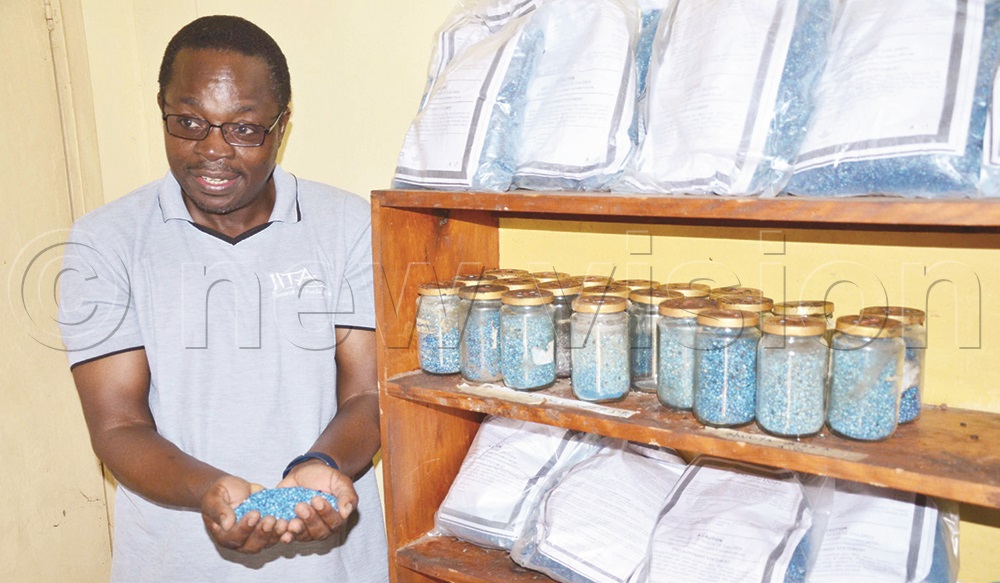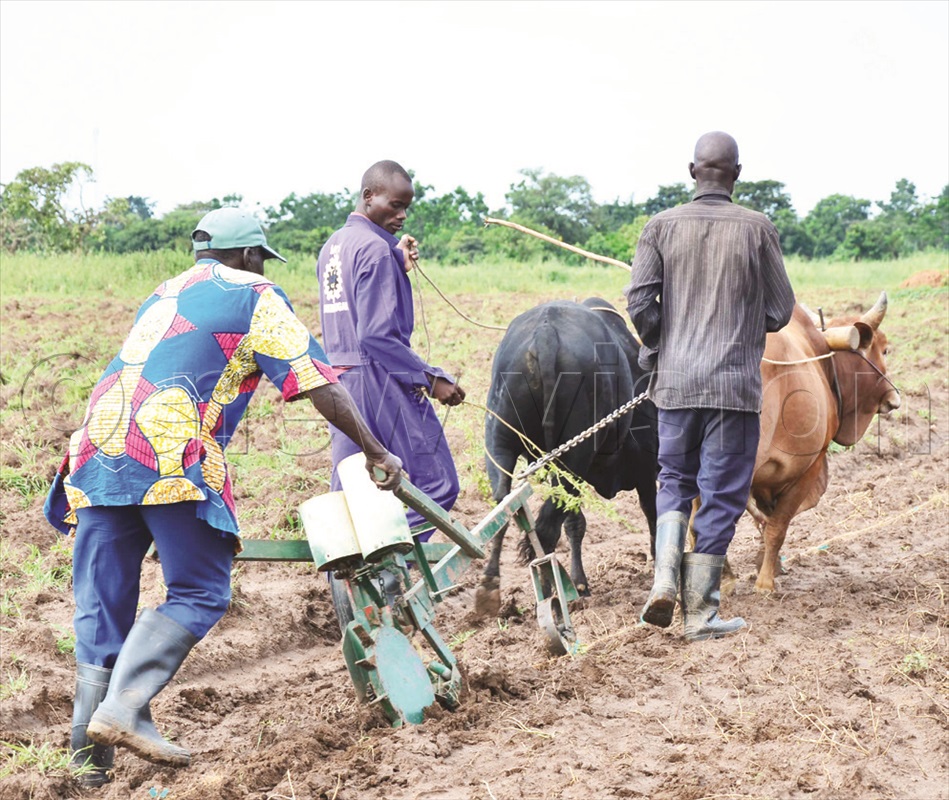By Herbert Musoke
Research and innovations are key to the introduction of new breeds, varieties and applicable technologies that improve production, productivity and profitability of agricultural enterprises.
Such innovations are made to improve the existing varieties for higher production, early maturity, resistance to climate change and diseases, among others.
On the other hand, innovations have been made with technologies to ease work on farms for improved production and productivity, but also to improve the quality of harvest.

The year 2023 saw several innovations aimed at improving production and productivity in agricultural enterprises, thus making them profitable.
Improved local chicken
The 2022 Ministry of Agriculture, Animal Industry and Fisheries report indicates that poultry is the biggest agricultural enterprise in Uganda with over 43 million local chicken, but many are kept under subsistence system where owners get eggs and hens for home consumption.
Such chicken take about a year and above to mature to sell at sh50,000 a cock and sh30,000 a hen. Each egg goes for sh500.
To improve the maturity of those local chicken, the National Agricultural Research Organisation (NARO), introduced an improved local chicken breed that weighs 2.3kg in five months to enable farmers to make money.

With this, farmers will make more money than those keeping the normal local ones that take a year to mature.
Henry Mulindwa, the project principal investigator with the National Livestock Resources Research Institute (NaLIRRI) under NARO, says the main aim of the project is to produce a local chicken breed that matures in months, just like the exotic ones.
Mulindwa says these are local breeds collected from across the regions known for keeping local chicken. They are then improved through selective methods, where the most outstanding chickens are selected and taken to the next level.
“We collected chicken from Lira, Apac, Gulu, Serere, Katakwi and Soroti districts, among others, to get the foundation stock. The criteria were mainly looking at the weight, height and egg size. They were all assessed, but those from Lira and Apac were slightly better,” he says.
They were put together and started the second screening for age after being exposed to the same conditions.
At week 16, all those that did not meet the parameters were dropped and the outstanding were then taken as the parent stock.
“During the selection, the mark for cocks is set higher than that of hens since the cocks carry the genes and can fertilise many hens to produce chicks with the needed traits for commercial purposes. Here we select the cream of the cream,” Mulindwa says.
Currently, by five months, the hens should be weighing between1.5kg and 1.8kg and the cocks 2kg to 2.3kg. They are, however, still screening such that this weight can be attained at three to four months, just like broilers.
Locals birds have been attaining this weight at 12 months and above, making the business unviable.
“We are now in the third generation and hope to screenthe sixth generation. After this, we will start on other traits like colour because some customers may be looking for a particular colour,” Mulindwa says.
Ox plough
Nelson Ewadu, the animal instructor at the National Semi-Arid Resources Research Institute (NaSARRI) in Serere district, says in 2019 they were assigned to come up with innovations that can make it easy for the farmers to manage their gardens and maximise production and productivity.
“To attain this, we innovated SAALI ox plough with planter and weeder implements, which make farming cheaper, easier than it is currently. These are separate implements that can be attached on a plough frame if a farmer has already got one and uses the same animals,” Ewadu says.
The ox planter has two containers; that is, for seed and fertiliser, respectively. It is made with a rotating wheel with short pipes that dig holes in the ground and drop seeds and fertilisers through a yoke.
“It is the yoke that we change according to the crop seed we are going to plant as they differ inside. We, therefore, change the yoke according to the size of the holes in it to allow seeds to pass through. The holes are made in a given spacing for proper spacing,” Ewadu says.
John Obuo, an animal instructor at NaSARRI, says the oxen are first trained if one is to use them for planting or weeding, although they have been ploughing.
“The training may take about two to three weeks as they are mainly trained to follow a tape at the beginning and later the row that has been made. These animals should be healthy, well-fed and trained together and over two years old. They should be replaced at five to six years,” he says.
Obuo says one needs three people to operate the oxen using ox plough planters. They can plant two to three acres in one day, yet to plant the same space, one needs over 30 workers with each being paid sh10,000.
Ewadu says the weeder is at its final stage and is expected to be sold at sh80,000. The planter will also cost the same amount.
The weeder is used to weed between rows and then a farmer will have to weed around the plants with a hoe or by hand-picking.
Water for irrigation
Farming as a business cannot rely on rainwater only. This is why the Government has come up with Water for Production initiative to support farmers all year round.
Eng. Ibrahim Ssenfuma, the Water for Production project co-ordinator in Gomba district, says this water can be given to a community and individuals.
“Beneficiaries must provide land on which the water dam or well will be constructed. For the community, they should hold a meeting and minutes be written, which will be attached to the request form and a copy of acceptance letter from the landowner who will have provided the land. The land title or agreement is also included,” Ssenfuma says.
For individuals, however, they are given irrigation equipment and they must have a reliable water source.
The forms are picked from the district agriculture or production office, filled in and stamped by the sub-county chief and the chief accounting office at the district, then they are submitted to the district production office for validation.
The project runs under a cost-sharing system where beneficiaries pay 25% and the Government contributes 75% towards the cost of the irrigation systems powered by solar energy.
However, this applies to equipment costing less than sh18m. However, if one wants the system powered by fuel, they pay 75% and the Government pays 25%. But it applies to the equipment not more than sh5m.
This is aimed at ensuring farming all year round other than depending on natural rains, which occur two seasons in a year and prevent losses during bumper harvest.
New crop varieties
Scovia Adikini, a crop breeder at NaSARRI, says they are coming up with three new finger millet varieties (Naro Mil 1-2 and Serem 2), four new varieties for sorghum (Naro Sog 1-2) and one for green gram (Narogram 2).
She says they are producing foundation seed, which will be multiplied in partnership with select farmers for supply countrywide.
Apart from producing new crop varieties, Adikini adds that NaSARRI works with farmers through groups to teach them the best agronomic practices of planting in lines and rows, use of fertilisers, pest and disease management, as well as proper post-harvest management.
This will increase productivity and improved harvest from the same space, hence resulting in increased profit.
High value crops
The Government, through the National Agricultural Advisory Services, intensified the production of high-value crops including Hass avocado, macadamia and cashew nuts by giving out cost-shared seedlings, where farmers pay 30% and the Government tops up with 70%.
However, there has been a growing concern of availability of ready market, which is why Musubi Farm has established an oil production plant at Kasokoso village in Najjembe, Buikwe district. They produce oil from avocado.
Hesbarn Cheruiyot of Musubi Farm says they have started producing oil that can be used for cooking as well as the manufacture of skin and hair products.
“This will not only produce quality natural cosmetic products, but also increase the demand of avocado thus creating a market. This will lead to increased prices, thus making avocado farming profitable,” he says.
Julius Bigabwa, one of the winners of the Best Farmers’ competition, says with macadamia nuts, they have come up with machines that crack them to get the seeds and also extract oil, which is expensive. A kilogramme of cracked seeds goes for sh100,000.





